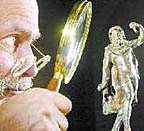 "Nineteen years ago, Robert Cohon strode through the classical galleries of the Nelson-Atkins Museum of Art in Kansas City, Mo. The light was low. The room was quiet. A spotlighted statue in a display case stopped Cohon in his tracks.
"Nineteen years ago, Robert Cohon strode through the classical galleries of the Nelson-Atkins Museum of Art in Kansas City, Mo. The light was low. The room was quiet. A spotlighted statue in a display case stopped Cohon in his tracks.
The barbarian was only 7 inches tall, but, Cohon says, 'it was spectacular.'
The nude figure had muscular legs and a cape. It held the right hand high, the other low, as if carrying a shield and a weapon. The dark bronze surface was mottled with tiny patches of red and green patinas. With its twisted posture, the look on its face and a bandaged leg, the barbarian appeared wounded and in pain.
To someone steeped in the art of ancient cultures, this small bronze statue of a warrior was quite a prize. Its presence at the museum helped Cohon decide to take a job as the Nelson's curator of antiquities.
Yet, within a couple of years, his elation turned to doubt amid questions about the figure's authenticity.
Could it really be 2,000 years old? Or was it of more recent vintage - from the Renaissance, say, or even a forgery?
The barbarian appeared to be left handed and the barbarian's face was Christlike, with flowing locks and a goatee. His thigh was bandaged, also an unusual detail for 2nd century Roman depictions of conquered barbarians.
Now, 17 years later, Cohon has pieced together the truth, and in April, for an audience in a Nelson-Atkins auditorium, he revealed what he learned about the little bronze warrior and the thrills of archaeology."
No comments:
Post a Comment